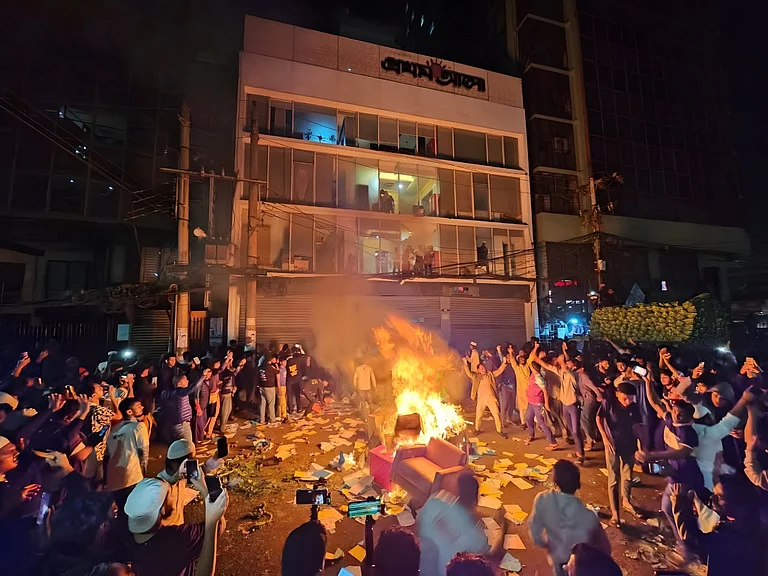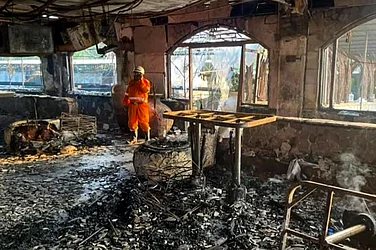“This noble building is 500 feet from north to south and 300 from east to west, and 60 feet in height. It was formerly supported by 260 columns of black marble (later found to be granite) of which number, only 150 now remain. These columns are surmounted by superb cupolas, the whole forming a most beautiful Syrian roof executed with great ability and tastefully ornamented with carved work and flowers in the sculpture,” Major William Francklin, who served the British East India Company as a regulating officer at Bhagalpur (Bihar), wrote of the mosque in his journal in 1810, when he visited the site two years after the ruins were discovered. “Common description must fall short in the attempt justly to delineate the feature of this magnificent pile. It requires the pencil of the ablest artist,” he wrote about the 14th-century mosque in Malda district of West Bengal.
The Adina (Friday in Persian) mosque was the largest mosque in the whole of the Indian sub-continent when it was completed in 1374. The reigning king was Sikandar Shah, son of Iliyas Shah. In 1342, Iliyas became the first ruler of the independent Bengal Sultanate (1342-1538) after he declared independence from the Delhi Sultanate. The father and son successfully resisted Delhi Sultan Feroz Shah Tughlaq’s military expeditions in 1353 and 1359 to annex Bengal. According to American historian Richard Eaton, Sikandar, having successfully defended his kingdom, projected his claims of power by erecting a monument greater in size than any edifice built by his North Indian rivals. “The inscriptions inside and outside the Adinah Mosque… are the finest that I have seen,” Henry Ferdinand Blochmann, a German orientalist and a principal of the Calcutta Madrasah, wrote in his 1873 book, Contributions to the Geography and History of Bengal.
However, it was not intricate work on the walls that impressed Europeans and locals. It was the scale and size. “The masjid was almost as big as the Great Mosque of Damascus,” wrote John Hubert Marshall, the Director-General (DG) of the Archaeological Survey of India (ASI) between 1902 to 1928, in his essay titled, The Monuments of Muslim India. According to Alexander Cunningham, the first DG of the Archaeological Survey of India (ASI), the mosque “is looked upon by the Bengalis as one of the wonders of the world”.
The mosque bears rather unmistakable connections with Hindu structures—stones carved with Hindu motifs are part of the mosque’s architecture. This makes it evident that the mosque was built by destroying an Adinath Temple to be precise, claims Hindutva activists like Sourish Mukherjee, the spokesperson of the West Bengal unit of Vishwa Hindu Parishad, a sister organisation of India’s ruling Bharatiya Janata Party (BJP). Hindutva voices say it must be pulled down and restored to an Adinath or Shiva temple.

This demand is being built over the past few years on social media, and on ground in Malda district, where Muslims made up more than half the population according to the Census 2011. These voices got louder after the Supreme Court’s Ram Temple-Babri Masjid verdict, and recently found more oxygen after a local court in Varanasi, Uttar Pradesh, ordered on May 16 to seal a portion of the Gyanvapi mosque premises for further examination of alleged Hindu ancestry.
Is the story of Adina masjid as obvious as Hindutva activists make it sound?
Hazrat Pandua, now known as Pandua, located in Malda district 370 km north of Kolkata, was a lost town covered in forests until Scottish physician and geographer Francis Buchanan-Hamilton found it in 1808 while touring the district in search of the ruined city of Gour that served as Bengal’s capital for several centuries under both Hindu and Muslim kings. The discovery of this other ruined township drew many interested people to the site. Henry Creighton, who worked as the superintendent of Charles Grant’s indigo farm at Guamalati (a place next to Gour) during the 1780s and 1790s, is credited for having undertaken the first thorough work of detailing the ruins of Gour—all in his personal interest. He is also the person who for the first time brought forth the idea that Hindu structures in Gour were demolished and converted into Islamic architecture. His book was posthumously published in 1808, incidentally also the year when Buchanan-Hamilton discovered Pandua.

Since then, a number of European administrative officers and scholars published their accounts in the 19th century dealing with Adina mosque and Pandua in detail—Buchanan-Hamilton, Major William Francklin, John Henry Ravenshaw, Henry Blochman and Cunningham, among others. Four of them mention the Hindu motifs and conclude that they were part of Hindu temples. But none offer even a hint that the mosque was built on the ruins of a temple.
Buchanan-Hamilton found very little traces of remnants of Hindu past in the existing structures in Gour, whereas they were found much more frequently in Pandua—apart from Adina masjid, materials from Hindu buildings of older period were used in the Boro Sona Masjid or Bardwari, the Eklakhi monument and the Chhoto Sona Masjid, among others. This led him to infer that the ruins of Hindu buildings in Gour were used to build new Islamic structures in the new capital of Pandua, about 30 km north of Gour, where Iliyas Shah moved his capital after breaking away from the Delhi Sultanate. Gour was rebuilt after the capital returned there in the mid-15th century, as Pandua became desolate.
“Gaur seems to have been plundered of every monument of former grandeur that could be removed,” Buchanan-Hamilton wrote in his notes published in 1810, “...there can be no doubt that the materials of the very extensive buildings reared there (in Pandua) have been taken from the Hindu buildings at Gaur.”

John Henry Ravenshaw of the Bengal Civil Service, who served as the magistrate and collector of Malda during the 1860s, offered some details about Gaur and Panduah in his book Gaur: Its Ruins and Inscriptions, which posthumously published in 1878. He thought this whole new capital was built out of remains of earlier Hindu structures. Speaking of Hazrat Pandua, he wrote, “Though it cannot boast of such antiquity as Gaur, its remains afford stronger evidence than do those of the latter city of its having been constructed mainly from the materials of Hindu buildings.” He detailed how most of the important Islamic architecture Pandua used materials that evidently formed parts of ruins of Hindu households and temples.
However, none of the historical chronicles of this episode make it clear whether these Hindu buildings in Gour were destroyed while the capital was being shifted to Pandua, or they fell victims of earlier aggressions, as the town had been invaded multiple times before. Cunningham assumed Pandua was already a place of note by the early 13th century when it was chosen as the new site of the Sultanate capital. According to Ravenshaw, the North-South alignment of its tanks spoke of a Hindu past. Cunningham wrote in Report of a Tour in Bihar and Bengal in 1879-80 that Hindu antiquity of Pandua “is proved most incontestably by the numerous Hindu remains, both of sculpture and architecture, which still exist at Pandua—some lying loose, others built into the Adina masjid, the Ek-lakhi Tomb, and the buildings about the shrine of Nur Kutb Alam.” However, there is no account of destruction having occured at Pandua itself.
Cunningham also noted that building new structures using materials from earlier structures was common practice in early Islamic architectures of Gour, Pandua and their neighbourhood. He cited that the Jame Masjid in Malda built during Akbar’s time in the 15th century used materials from older Hindu temples and a mosque. Buchanan-Hamilton mentioned materials for a bridge of three arches over a rivulet in Pandua, partly constructed of stones, “have manifestly come from the Hindu temples.” Even the ASI’s current signboard at the Adina mosque reads: “The architectural members of some earlier structures have been utilised partly in the construction of the mosque.”
And despite the site having been a favourite hunting ground of European scholars and archaeologists during the 19th and 20th centuries, no one hinted at any temple occupying Adina’s place in the past.
(This appeared in the print edition as "Next in Line?")
Snigdhendu Bhattacharya in Calcutta


























